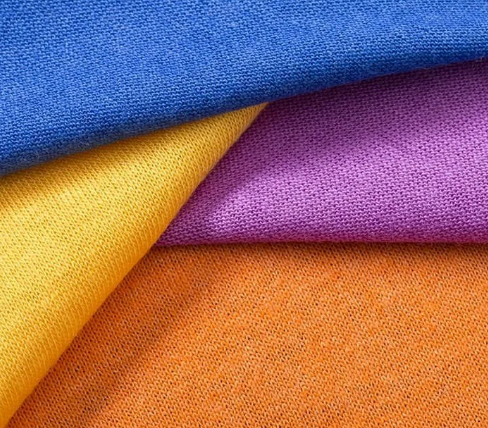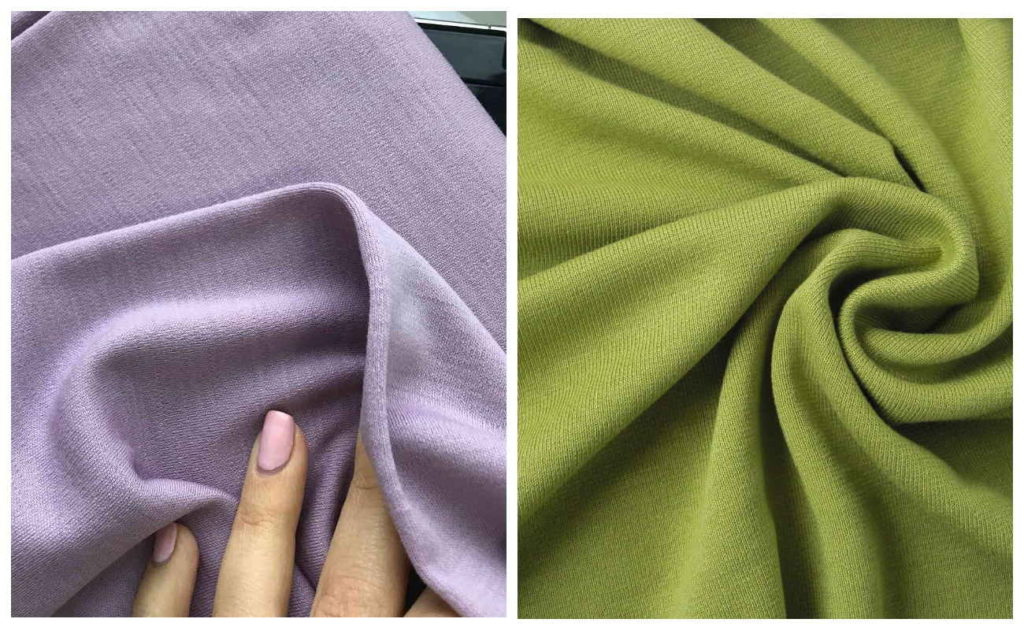Now products made from this material are present in almost every wardrobe. This is an inexpensive fabric that has many advantages and has deservedly gained its popularity around the world. Jersey recognition secured comfortable to wear, versatility of use, durability and strength, low maintenance. The history of this material began in the Middle Ages on a tiny island in the strait between England and France.
What kind of fabric is jersey?
This material is a type of knitwear that was first produced on the island of the same name in the English Channel. The climate in these places is quite harsh and local residents needed fabric that would save heat in the piercing wind.
The wool for it was provided by a local breed of sheep, which had good thermal insulation.. For a long time, jersey was made only there and exported to Europe in small quantities for the manufacture of underwear.
Interesting! This material was discovered to the world by the Frenchwoman Coco Chanel, who was the first to use the fabric for sewing dresses and other clothes from her collections. For her, this material became one of her favorites.
At first, the public was very lukewarm about fashionable clothing made from fabric used to make underwear and tracksuits, but Chanel’s persistence and talent ensured the success of the jersey. The undeniable advantages of the fabric also contributed to this.

Description of material
Modern jersey is machine knitted knitted fabric. Over the centuries, the composition and technology for obtaining the material have changed repeatedly. Nowadays it is made by single-row weaving using a spinning machine. That's why on jersey products, on the front side you can very clearly see the characteristic pattern in the form of braids, similar to knitted. On the reverse side, the stripes of the pattern are located horizontally.
Compound
Jersey can be made from natural materials such as wool, cotton or linen, or synthetic fibers such as viscose. Initially, only wool from a special breed of sheep was used, which was bred only on the island of Jersey.
Nowadays, alpaca or vicuña wool (a distant relative of camels, which is bred in the mountainous regions of South America) is also used in production. Viscose, which is made from cellulose, is most often used from bamboo or eucalyptus. Other common synthetic fibers include lycra, polyester and elastane.
Modern technologies make it possible to produce jersey from different materials, combining their properties.

Fabric properties
The qualities and consumer properties of a material are determined by the raw materials from which it is made.Natural wool has good heat-saving ability, absorbs moisture from the air and allows the skin to breathe. The addition of various synthetic fibers makes the fabric less wrinkled.
Viscose is used to obtain more durable material, and elastane allows him stretch and not lose its original appearance. Additives of various substances add to it antibacterial, water-repellent and many other properties. This is very important when creating clothing for sports and outdoor activities.

Pros and cons
As with any clothing material, jersey has its advantages and disadvantages. They may vary slightly depending on the composition of the fabric, but they are also common to all knitwear.
The advantages of jersey include:
- Hygroscopicity of the material. The ability to absorb and release moisture regulates heat transfer and increases the wearing comfort of such clothing.
- Air circulation is also determined by the method of knitting fibers used during production.
- Regardless of the type of raw material, any knitted fabric is particularly soft.
- It is easy to care for and does not lose its properties when washed or ironed.
- Jersey does not have any specific cleaning regime requirements.
- The material wrinkles little, retains its shape well, and there are no creases on clothes made from it.
- Jersey products have a long service life.
- The fibers of the fabric are easy to dye, and in general it is quite versatile.
Taken together, this makes it a favorite material for designers and fashion designers. Another advantage is its low weight. Clothes made from this fabric are very light and do not create discomfort when worn.It drapes easily and makes it possible to form any folds without ironing them.

The disadvantages of the fabric are partly a consequence of its advantages:
- The material absorbs water very well, so drying it takes a long time.
- Due to the nature of the weave, jersey stretches unevenly in different directions.
- You will have to remove heavy stains from clothes using household chemicals, since they cannot be boiled.
- Products made from natural wool may develop pellets during use, spoiling their appearance.
- Synthetic jersey tends to accumulate static electricity and unpleasantly stick to other parts of clothing.
How is it different from others similar?
It is not difficult to distinguish jersey from other fabrics when choosing and purchasing clothes. The material should be soft and elastic, easily stretchable without forming creases. In addition, it is better to buy quality items in trusted stores, where there is less risk of getting a fake.
When purchasing fabric for sewing at home, it is also easy to verify the authenticity of the jersey. It is enough to pull the raw edge of the canvas to the side, which should then curl into a small roller. If possible, the test can be carried out using a small cut of the material. Its edges begin to turn to the sides.
Types of Jersey
Modern classification distinguishes material by its constituent fibers. There are three main types - natural, synthetic and artificial.
The first group includes fabrics containing wool, cotton, linen or silk. It is possible to add a small amount of viscose and other synthetic fibers:
- Elastane is often added to cotton jersey to make the material durable.
- The most expensive type of jersey is silk fabric. The surface of the material is particularly smooth and attractive in appearance.
- Wool jersey is the warmest type of knitwear, providing comfort at any ambient temperature.
The base of synthetic jersey is polyester. To give better properties, elastane, lycra, spandex and other fibers are added to the fabric. All of them serve to improve elasticity; this type of fabric is also called stretch jersey. The main positive characteristic of synthetic material is its wear resistance and durability. From this point of view, knitwear can even compete with nylon.
Artificial fabric is material based on wood fibers. Most often, bamboo and viscose fiber obtained from cellulose processing are used for this. These materials are environmentally friendly and do not cause allergic reactions.

What are they sewing from this fabric?
Clothing manufacturers love and value jersey for its versatility. Almost everything is sewn from this knitwear. For example:
- The material is ideal for sewing underwear, both men's and women's. The main type of knitwear here is artificial, based on viscose. Cotton and silk jersey are also used.
- A large number of children's clothing are manufactured, which are required to be easy to care for and durable.
- Thanks to Coco Chanel, this fabric has firmly become one of the materials for making dresses.
- Jersey outerwear is also available.
- Wool knitwear is used for sweaters, jumpers, jackets and jackets. Cotton fabric is used for sewing casual clothes - suits and shirts.
It's easy to sew from jersey at home.The material does not stretch much when processed on a sewing machine, which makes working with the fabric much easier. In places where they are cut, the fibers do not crumble or fall off. That's why no need to overlock when sewing. It is advisable to wash the material before cutting - this will help avoid further shrinkage.

Subtleties of caring for things made from this material
You can extend the life of your favorite clothes by following the rules of caring for them:
- Jersey products can be washed either by hand or in a washing machine. Specific instructions are given on the labels, but the general rule is a gentle program in the machine and a temperature of no higher than 40°.
- When washing by hand, rinse clothes in water at a temperature of approximately 20°.
- Be careful when washing items with bright colors that may fade.
- White jersey clothes must be washed separately from colored ones.
- During machine spinning, the drum rotation speed cannot be set above 800 rpm.
- To avoid stretching of products, it is recommended to dry them in a horizontal position.
- The proximity of heat sources is also undesirable.
- Clothes should be ironed at a minimum temperature, following the manufacturer's recommendations. It is advisable to place a thin cloth or gauze under the iron. Without this, the fabric may acquire a characteristic shiny shine.
- When storing, avoid exposing clothing to direct sunlight. Even the most durable paint is subject to fading.
- Since jersey does not wrinkle too much, products made from this fabric can also be stored folded.

Important! If your sweater or jacket does get wrinkled, you can solve the problem by hanging it in a steamy bathroom. It straightens out even the smallest wrinkles. Then the clothes will need to be dried in a ventilated area.In the same way, you can get rid of the unpleasant odor that appears during long-term storage.


 0
0





